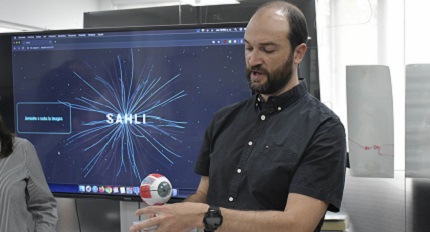Cases & Voices
In Colombia: Robot created with the support of RENATA diagnoses retinal diseases with 99% of accuracy

Thanks to an alliance between the Simón Bolívar University's MacondoLab, Cofca, Atlantic Governor, CaribeTIC and RENATA Colombia*, patients will be able to detect eye disease in time through a robot designed for this purpose. SAHLI, spanish acronym for "Autonomous Independent Reading Skills System" can diagnose four types of human retinal disorders in 10 to 20 seconds with 99% reliability.
(Source: LaFM and Digital Integrated System / Photo: Hansel Vásquez, by El Heraldo) “This is the sign that medical knowledge already transcends the boundaries of an office and now we can make decisions more accurately and quickly,” says Luis Escaf Jaraba, scientific director of the Caribbean Ophthalmology Clinic (Cofca).
The creation of this technological development took more than 12,000 hours of work at the MacondoLab Prototyping Laboratory, the Unisimón Business Growth Center, where physicists, chemists, mathematicians and systems engineers converged with Cofca's expertise to create the algorithms that allow the robot to discover eye degenerations. "The complexity was how to get that machine at this speed of time to detect damage in the three million characteristics that a retinal image can hold until we get the result of a cutting-edge medical program," says Reynaldo Villarreal González, Director of laboratory.
How does the robot work?
SAHLI has the appearance of a web page on which the digital file of a patient's macula (retinal examination) tomography is loaded and within seconds identifies whether there is age-associated macular degeneration, age-associated macular degeneration dryness, choroidal thinning (middle layer of the eye), epiretinal or cystic membrane, diabetic macular edema or other cause. Escaf Jaraba explains that SAHLI modulates all the information it receives to convert it to images through algorithms. From this, it interprets and correlates with a pathology. "When a satellite sends photos to Earth, what it commands are wavelengths that hit computers that convert them into images. That's what this platform is doing", he says.
Detection of more diseases
Retinal abnormalities are related to age or diseases such as diabetes; therefore 80% of cases can be prevented if they are determined in time. "There are more pathologies and we are working to increase the capacity of SAHLI, which, being an artificial intelligence project, does not stop learning," says Santiago Morales, Cofca retinologist. Paola Amar Sepúlveda, CEO of MacondoLab and Vice President of Research and Innovation at Unisimón, acknowledged the importance of working together between universities, companies and the state. “Over a year, more than 12 Unisimón researchers joined the Caribbean Ophthalmological Clinic's medical team, supported by the Governor of the Atlantic, with over 12,000 hours to launch a new innovation that demonstrates that technology is made in the Colombian Caribbean, bringing innovation to the world."
*The National Academic Network of Advanced Technology, RENATA, is Colombia's national research and education network that connects, articulates, and integrates the academic and scientific community, the productive sector, and the state with each other and with the world for development. knowledge, research, education and innovation in the country.




